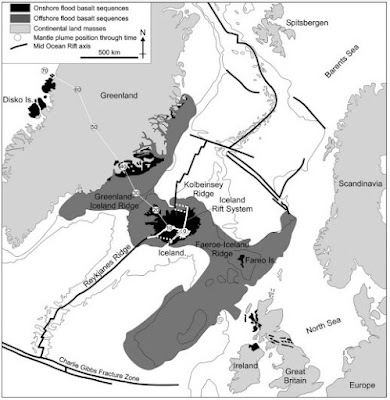Image Courtesy Journal of Geodynamics 43 (2007) 118–152
Volcanism in Iceland in historical time: Volcano types,
eruption styles and eruptive history
T. Thordarson, G. Larsen
From
Thūlē (Thȳlē ), ēs, f., = Θούλη or Θύλη,
I.an island in the extreme nortl of Europe; acc. to some, Iceland; acc. to others, Mainland (the largest of the Shetland lslands), Mel. 3, 6, 9; Plin. 2, 75, 77, § 187; 4, 16, 30, § 104; 6, 34, 39, § 220; Tac. Agr. 10; Stat. S. 3, 5, 20; 4, 4, 62; Claud. III. Cons. Hon. 53.
For a good treatment of the problem of Thule's whereabouts, see
https://www.jstor.org/stable/3296920#metadata_info_tab_contents, The Problem of Pytheas' Thule, Ian Whitaker, The Classical Journal, Vol. 77, No. 2 (Dec., 1981 - Jan., 1982).
Sometimes my research into things old and dusty takes a new turn as a result of recent publications. A good case in point is a proposed identification of the mysterious Thule with Iceland by Dr. Andrew Breeze of Pamplona. He has made his case for the location of this farthermost northern land in "The Houseman Society Journal" (see https://greekreporter.com/2022/11/18/greek-discovery-iceland/).
As a rule, I dislike theories that rely on word corruption. And, in my experience, the overwhelming majority of scholars also tend to eschew that method. It is well and fine to have an original, correctly spelled word, and then be able to show how it became corrupted over time. But to do otherwise is an extremely hazardous undertaking.
Over the years, I've read a lot about Thule. None of the explanations offered to date are particularly satisfying. Iceland has always been a prime contender, although no one has succeeded in connecting that place with the name Thule.
As Thule as written in the Greek is clearly not a Greek word, the first thing a detective of ancient geography should do is to ask where the word came from. If we disallow an otherwise unattested corruption, we must naturally look to one of the earliest known group of languages found in the extreme north of Europe - the Finno-Ugric family.
We have a Finnish word tuli: tule-, 'fire'. Their word for a volcano is tulivuori, composed of tuli, 'fire', and vuori, 'mountain.'
Given that Iceland, one of the favored candidates for Thule, was most certainly a land of fire in terms of the major volcanism it constantly displays, could Pytheas have gotten the name from a Finnish source - or perhaps from the Sami? This last people had dolla, pronounced /ˈtolla/.
A fuller analysis of the Samic word for fire can be found in
– Proto-Uralic *tuli ‘fire’ > Proto-Samic *tole
̮
> SaS dålle /dollə̑/ N dolla I tullâ Sk toll K то̄лл /tōll/
And, again, from
Appendix 1: The Balto-Fennic word-lists and etymologies
Appendix 2: Saamic wordlists and etymologies
Perhaps the best discussion of this word in Samic is from https://kaino.kotus.fi/algu/index.php?kkieli=en&t=lekseemi&lekseemi_id=62393. I urge my readers to consult this source for all the various forms of the word in the various Samic dialects.
Far-fetched as this notion may seem, an Icelandic archaeologist believes he has found evidence of a Sami settlement in Iceland that predates the Norse settlement there (see https://arcticportal.org/ap-library/news/2136-could-sami-peoples-have-been-among-the-first-settlers-in-iceland#:~:text=According%20to%20the%20Icelandic%20newsprovider,resources%20from%20St%C3%B6%C3%B0%20in%20St%C3%B6%C3%B0vafj%C3%B6r%C3%B0ur).
According to Dr. Bjarni F. Einarsson,
“There are highly developed tools made from stone at Stöð. They could be knives, scrapers, even planers. This is, in my opinion, one of the most remarkable things to have been found at Stöð. This is not something people invent on the spot and learn. This is really complicated technology that is only learnt person-to-person, generation-to-generation. And it is possible to ask: who had this sort of tools in the Nordic region? And there really is only one answer: the Sami. So, it could mean that some members of this group could have been Sami, or of Sami origin and had learnt this at home and then followed these people over the sea."
In a private communication with Einarsson, I was told that "The next step is a series of DNA testings which might shed a light on this problem. That will take at least two years."
The archaeological reports on the Stod excavation (in Icelandic) may be viewed here:
Whether or not we can confirm a pre-Norse presence of the Sami in Iceland, it remains an intriguing possibility that the latter people knew of Iceland in the ancient period and that they called it Fire Island - a name which came to be preserved by Pytheas as Thule.
It goes without saying that those Sami who knew of Iceland would have been the coastal peoples. For a good article on them, see https://www.laits.utexas.edu/sami/dieda/hist/nor-sami.htm.
